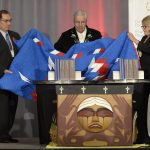Cultural genocide: When we debate words, we delay healing
What is “cultural genocide” and why does it matter? This powerful label was first adopted by the Truth and Reconciliation Commission (TRC) last June. It was meant to describe a colonial assimilationist policy, aimed at extinguishing Canada’s indigenous peoples “as distinct legal, social, cultural, religious, and racial entities.”
The long-suffering survivors of the residential schools celebrated this declaration with rapturous applause. But what followed was a storm of controversy on whether “genocide” was an appropriate term for this purpose; a controversy that has distracted us from confronting the reality facing Canada’s indigenous peoples.
As a former United Nations prosecutor at The Hague, I am well aware of the legal definition of this crime. What disturbs me is how this polemical debate disregards the deeper meaning of words; the importance of recognition for healing wounds. The TRC process was not a criminal trial. It was an opportunity for some 6,750 survivors to break the silence, to tell their heartbreaking stories to fellow Canadians.
Whether “cultural genocide” is a proper legal label is less important than its reality as a mourning metaphor; and abstract disputations about precise terminology are even less important than the urgency of national reconciliation with Canada’s indigenous people.
The history of the UN Genocide Convention sheds some light on this controversy. It was adopted in 1948, in the shadow of the Holocaust, following months of negotiations, after delegates agreed to include “physical” and “biological,” but to exclude “cultural” genocide from an earlier proposed draft. This was motivated by two reasons: On the one hand, some believed that the Nazi exterminations in gas chambers was a different crime than the destruction of historic monuments and minority languages; on the other hand, most non-European nations were still under colonial domination so their devastating experience with “civilizing missions” was not reflected in the debates.
Although “cultural genocide” had a short life, it was seriously considered as a legal concept. It is best described today as the ghost of proposed crimes past. What is most relevant for the residential school policy is that the “forcible transfer of children” – initially qualified as a form of “cultural genocide” – was retained in the formal definition as one of the acts by which genocide could be committed.
The postwar trial of Nazis had included prosecutions for the kidnapping of thousands of “racially valuable” children from occupied Poland. More recently, the International Court of Justice has interpreted the permanent transfer of children as “biological” genocide because, like forced sterilization, it destroys a group’s reproductive capacity. Whether the temporary removal of children for the purpose of destroying a group’s culture also qualifies is a matter of legitimate debate. At the very least, if accurate legal labels are that important, to the extent that residential school policy constitutes persecution of a group because of its identity, then it qualifies as the equally serious category of crimes against humanity. So why the storm of controversy about the TRC’s declaration?
As the legislative history demonstrates, even as a legal concept, “cultural genocide” is not as far-fetched as some may imagine. But the TRC used it reasonably as a non-legal descriptive term, and what is even more important, the survivors see it as a recognition of their intense grief and anguish. We should not underestimate the power of words in redeeming the humanity of victims. It could even be said that “cultural genocide” is more important as a mourning metaphor rather than a legal label, because the moral imperative facing us as a country is healing and transformation, and not sterile debates on taxonomy.
Moving forward, the challenge is ensuring that Canada respects the UN Declaration on the Rights of Indigenous Peoples so that we can make the legacy of colonialism a thing of the past. The reality today is that among indigenous Canadians, 40 per cent of children go to bed hungry, and the infant mortality rate is 2.5 times, the homicide rate six times and the incarceration rate 10 times the national average. Whether we call the past “cultural genocide” or something else, this shameful situation is obviously connected with a history of forced displacement and ethnic demonization.
How can we champion human rights at the UN if we cannot clean up our own backyard? Why don’t we replicate the outpouring of compassion towards Syrian refugees for our indigenous brothers and sisters? Moving from historical truth to national reconciliation – the challenge the TRC has put before us – is a litmus test of our self-conception as Canadians. There are hopeful signs of political progress. But in responding to this urgent call, we must also consider how each of us can contribute, as individuals and communities, to building a just future.
Perhaps in this way, instead of debates on “cultural genocide,” the next generation will dwell on cultural jubilation, as we celebrate the redemption of our shared humanity.
Contributed to The Globe and Mail
Published








